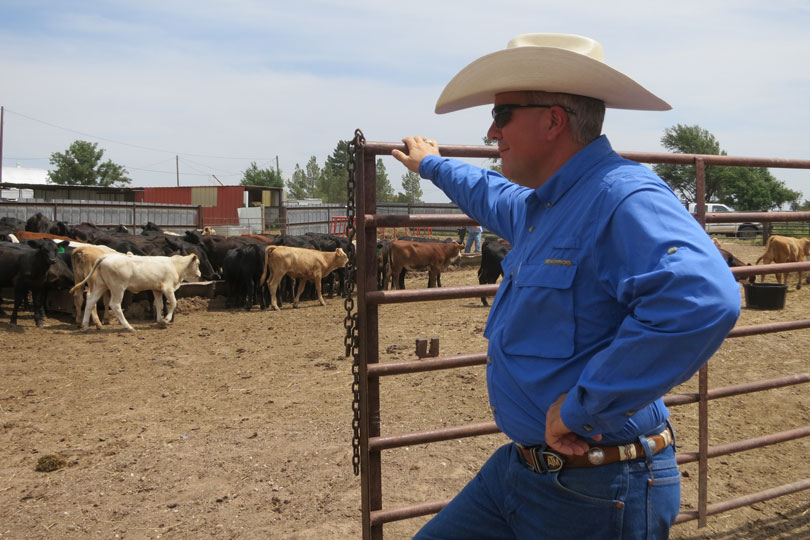By Jessica Domel
Multimedia Reporter
If flies are bugging you or your livestock, now is the time to take action.
There are several methods available to control flies, according to Dr. Bob Judd, Waco area veterinarian and host of Texas Vet News on the Texas Farm Bureau (TFB) Radio Network.
“Fly control is not that expensive compared to the return, and you can start with fly tags and tag cows and calves early in the spring,” Judd said. “By tagging early, you may need to retag again in June because July and August are the peak fly times, but you will get much better fly control.”
Feed-through fly control is another option, and it has become very popular in pasture-based beef production systems.
“(If these) products are not used correctly, it limits their effectiveness,” Judd said. “It is important to understand that these chemicals do not have any effect on the cow, because their effect is in the animal’s manure.”
The active ingredient in feed-through fly control moves through the animal’s gastrointestinal tract unchanged and is deposited in manure.
There are two types of feed-through fly control products—insect growth regulators (IGRs) and larvicides.
“IGRs interfere with the progression of normal fly development, and they delay the progression of fly larvae from one stage to the next,” Judd said. “They generally only target one species.”
The most common IGR only affects horn fly larvae.
Larvicides work differently.
“They elicit a structural change in the fly that leads to death before it is able to reproduce and can affect more than one species of fly,” Judd said.
It can affect horn flies, face flies and stable flies.
“If you are using an IGR and still seeing flies, it doesn’t mean the product isn’t working,” Judd said. “It means you have other flies than the horn flies.”
Feed-through fly control products need to be started one month before fly season to be the most effective.
“If you have not started a feed-through product, start it at this time,” Judd said. “Although feed-through fly control is good, it does not completely control the flies and should be used with ear tags, pour-ones, sprays or back rubbers to aid in controlling the flies.”
Another method of fly control involves another insect—wasps.
“There are wasps that are not any bigger than a pinhead that lay their eggs in the fly larvae,” Jay Wade Johnson, a rancher from Happy and member of the Swisher County Farm Bureau board of directors, said in an interview with the TFB Radio Network. “They kill the fly larvae that way.”
Johnson has been using the wasps to control flies on his ranch for more than a decade. He combines it with feed-through products and pour-ons when needed.
“No method is 100 percent successful, but between the three, we can do a pretty nice job of controlling flies,” Johnson said.
There are several companies that offer the fly control wasps. The company Johnson uses develops a plan with him tailored to his operation.
“They help you. You talk about the number of head of cattle you’re going to have, the area that you’re going to put them, and they tell you where the best place is to put them,” Johnson said. “Then, they’ll sign you up for a service. They sent you a shipment when it’s time to put a new batch out.”
When Johnson receives the wasps, he simply lets them go in the area specified in his plan.
“You just put them out, and they do their job,” Johnson said. “They don’t bother humans. When you think of wasps, you think of the ones that bite you, sting you and may make you cry. But these are little bitty. They have no interest in humans.”
The effectiveness of the wasps is dependent upon the moisture in the area, which also affects the number of flies in an area.
In drier years, you typically see fewer flies in most areas. In wetter years, there tends to be more flies.
“They still do a nice job of controlling them. It’s when you use some of those (fly control) products in combination that we seem to have our best control,” Johnson said. “You don’t get rid of them, but think of it this way, it is the difference between seeing 10 horn flies on the back of


Thank you so much for this article. I have just begun to notice the fly problem the last few days in our area, west edge of Celina in Denton County. Our horses and cows are suddenly miserable and I’ve noticed more flies in the house. I have started using the fly-control spray on the horses, but the cows hate it. I am happy to know of some other forms of fly control. Is the feed-through method also safe for horses? Can you suggest a feed-through brand you would recommend? Also, who would you suggest I call about the fly control wasps?
Sincerely,
Sherri Henry
Hello Sherri – There are a few options for feed through IGR specifically for horses. I’d contact your local feed store and as them to help you track down something that’s right for you. They may have some inside knowledge on a product that is working favorably in your area. Your county extension office will also be a great source of unbiased information.
For cows, a lot of people have success with a “back-rubber” saturated with fly abatement products. You simply hang it high enough for cattle to walk under it and rub their back which allows them to self apply the product as they wish.
Tracy
if you can add DE ( diatomaceous earth ) to the feed, you will pretty much eliminate the flies
How much DE should each cow consume per day?